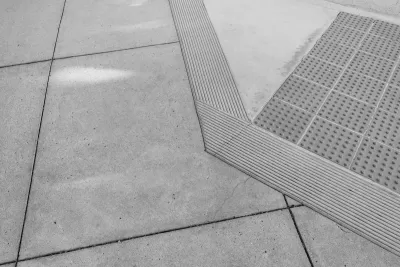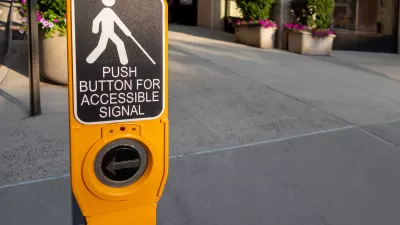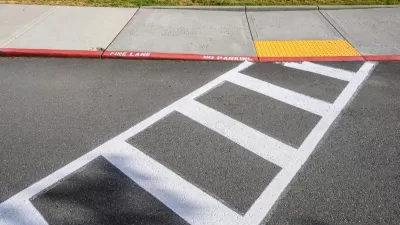A ‘best practices’ manual guides accessibility on streets and sidewalks, but remains legally unenforceable.

Although the Americans with Disabilities Act (ADA) is a landmark law that protects the civil rights of people with disabilities in many areas, “the ADA fails to address accessibility in areas known as the “public right-of-way,” which includes sidewalks, crosswalks, curb ramps, public transit stops, and more.”
The guidelines used since 2011 for the accessibility in the right-of-way, meanwhile, is not enforceable. As Marissa Bell explains in Streetsblog USA, the Public Right-of-Way Accessibility Guidelines (PROWAG) “was adopted by the U.S. Access Board [last year], but it still needs adoption by the departments of Justice and Transportation before it can truly make a life-changing impact for everyone who gets around in the public domain.”
Bell describes some of the most common accessibility features used in public ROW, and how they sometimes go wrong, pointing out that accessibility benefits more groups than just people with mobility impairments. “Ramps and other accessible infrastructure make life easier for everyone; it is vital that they are designed correctly or even designed at all.”
FULL STORY: PROWAG Can Make Cities More Accessible — So Here’s What You Need to Know

Study: Maui’s Plan to Convert Vacation Rentals to Long-Term Housing Could Cause Nearly $1 Billion Economic Loss
The plan would reduce visitor accommodation by 25% resulting in 1,900 jobs lost.

Alabama: Trump Terminates Settlements for Black Communities Harmed By Raw Sewage
Trump deemed the landmark civil rights agreement “illegal DEI and environmental justice policy.”

Why Should We Subsidize Public Transportation?
Many public transit agencies face financial stress due to rising costs, declining fare revenue, and declining subsidies. Transit advocates must provide a strong business case for increasing public transit funding.

Paris Bike Boom Leads to Steep Drop in Air Pollution
The French city’s air quality has improved dramatically in the past 20 years, coinciding with a growth in cycling.

Why Housing Costs More to Build in California Than in Texas
Hard costs like labor and materials combined with ‘soft’ costs such as permitting make building in the San Francisco Bay Area almost three times as costly as in Texas cities.

San Diego County Sees a Rise in Urban Coyotes
San Diego County experiences a rise in urban coyotes, as sightings become prevalent throughout its urban neighbourhoods and surrounding areas.
Urban Design for Planners 1: Software Tools
This six-course series explores essential urban design concepts using open source software and equips planners with the tools they need to participate fully in the urban design process.
Planning for Universal Design
Learn the tools for implementing Universal Design in planning regulations.
Smith Gee Studio
Alamo Area Metropolitan Planning Organization
City of Santa Clarita
Institute for Housing and Urban Development Studies (IHS)
City of Grandview
Harvard GSD Executive Education
Toledo-Lucas County Plan Commissions
Salt Lake City
NYU Wagner Graduate School of Public Service





























